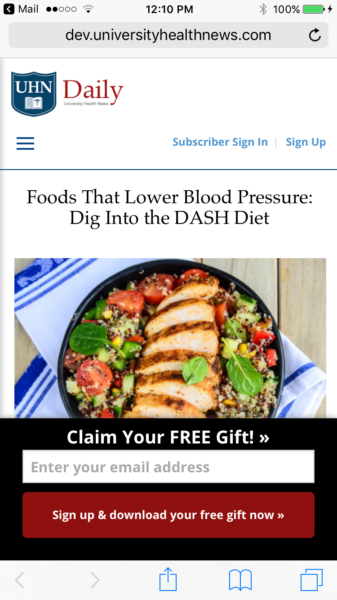Improve email capture rates by trying these five tests one at a time
Your floater, also referred to as a pop-up is most likely the most effective conversion element on your website. For most publishers we know who have floaters, they see 60% of email captures come through this element. And for those who launch them, they see a 20-50% lift in email capture rates right away.
What’s your current email capture rate?
Before you can test a floater, first figure out what number you’re competing against. Your email capture rate is the rate at which your website converts visitors into email subscribers:
To get this number, divide the total number of new email subscribers you acquired via your website in one month by the total number of unique visitors you received in that month. This will give you your site-wide email capture rate.
If during a given month you have 100,000 unique visitors arrive at your website (according to Google Analytics or a comparable measurement tool) and 2,000 of these unique visitors become new email subscribers (according to your email management program or service), your ECR is 2 percent (2,000/100,000 = .02 or 2.0%).
[text_ad]
How can you improve your email capture rate with floaters?
The first step is to implement them, but for the sake of this article, we’re assuming you already have them and are ready to improve upon your existing email capture rates.
Test #1: Implement mobile-friendly email capture.
In the last year, Google has cracked down on publishers serving floaters to mobile users. They told us that we needed to remove any pop-ups or floaters from mobile pages, or at the very least, from the first page a visitor sees. Otherwise, we’d lose rank. Most publishers obliged, and either turned them off on mobile, or got crafty with new types of ads, like placemat ads. If you have noticed a drop in email capture rates over the last year, your first test and overall improvement should to be exclude floaters from appearing on mobile pages, and design a Google-friendly solution like placemat ads.

Test #2: Capture the email address in the floater.
In the early days, we captured email addresses right in the floater ad itself, but over time, publishers wanted more information for their email list and to do that, they needed more robust email capture forms. So we transitioned from a one-step sign-up to a two or three step process that got the user to click on the floater ad, then fill out their information on the second page. Unfortunately, the more steps there are, the higher the bounce rate is. So now we recommend all publishers—unless they are lead-gen driven and need more information—stick to a one-step floater where they submit their email address right in the form, then double-opt in via email. Learn more about how to implement this on your own site.
Test #3: Offer a free download.
Instead of asking people to sign up for your newsletter offer them a free download in exchange for their email address. This is called the free-on-free offer that the folks at Agora established as a standard industry best practice. Our research has clearly proven that offering somebody a free download and a free email newsletter will generate about 65% more registrations than simply offering an email newsletter by itself.
Test #4: Test the headline.
Most of the publishers we know use the title of their free download, but some of our clients have been testing more creative headlines, and shorter headlines with great success. Instead of a 12-word title of a free report, try something that will catch their eye.
Test #5: Test the close.
Many publishers we know are testing the simple X or CLOSE text to close a floater, with fun opt-out language like “No thanks, I make enough money, I don’t want to make more.” Does it increase email capture rates? When done well. Some are also using a less rigid rejection that simply says, “Continue to site” which closes the window.
Beyond these major tests, there are lots of other floater tests to try, like swapping out your main image. Some publishers we know are testing photographic images against images of their free download, and are finding that the photographic images pull better. You also have several areas of copy to test, but just remember all tests should be done one at a time if you want to see what’s making the biggest difference.
In order to improve your email capture rates, a publisher can learn a lot from these tests.
As a multiplatform magazine, your content, audience development and revenue teams, through the metrics of organization, technology & measurement, will continually build and improve. And if you work with us, you can do that with complete confidence that you’ll succeed. In the end, you increase value to your stakeholders, and also to investors, talent or potential acquirers – because everyone wants to be associated with an organization with popular content and that’s financially successful. Want to work with us? Schedule a time to chat.